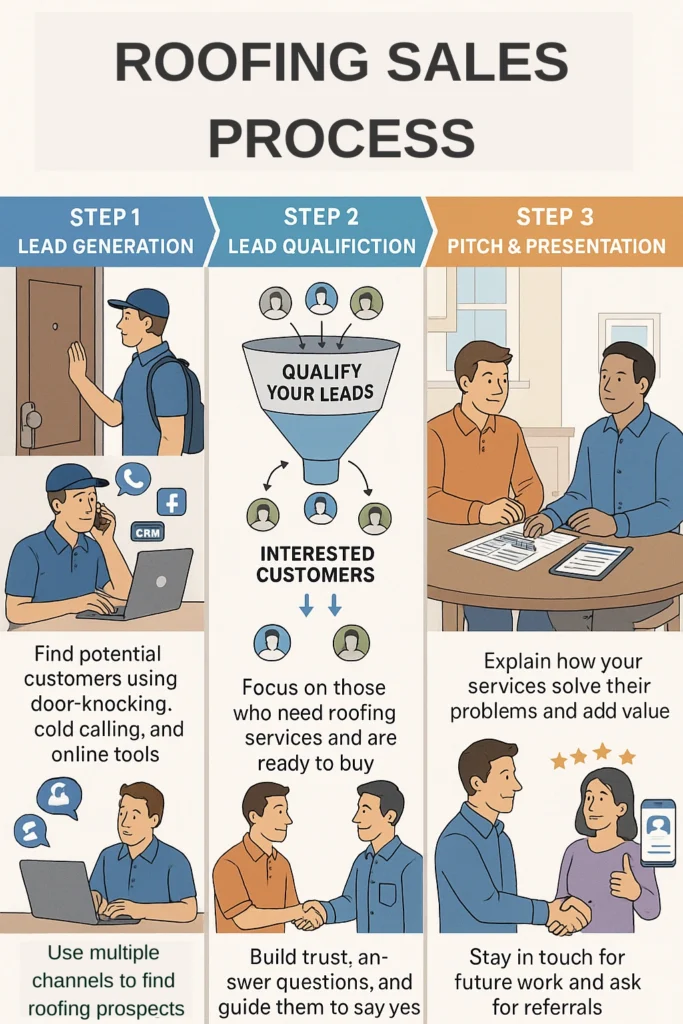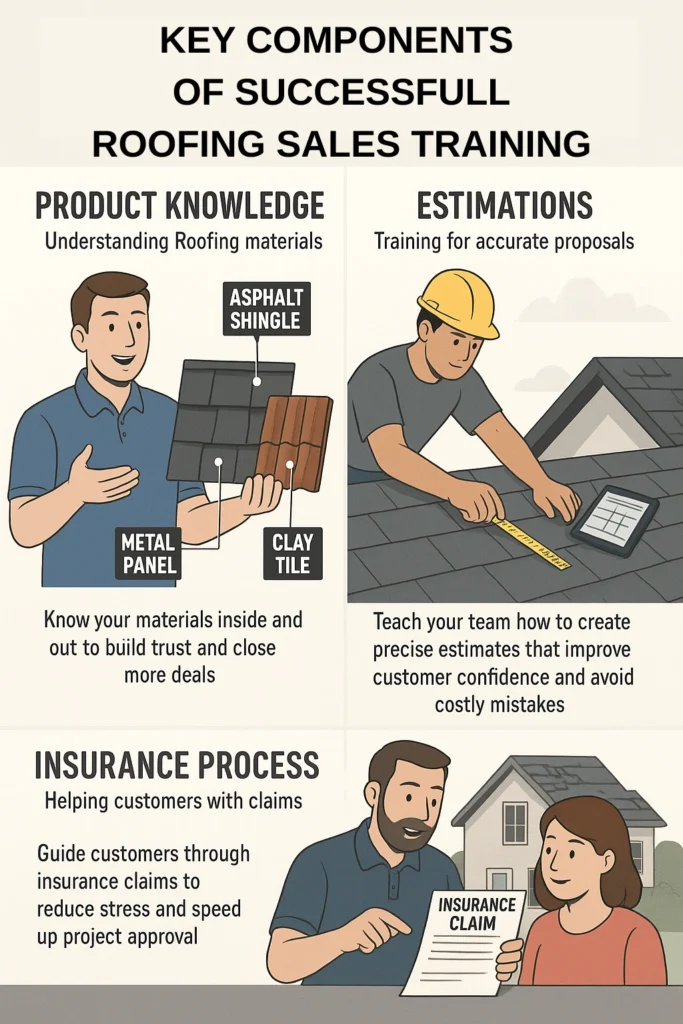Effective roofing sales training is intended for contractors wanting to grow their revenue. A good sales training program teaches your team to turn leads into happy customers. This leads to business success. Without training, your team might miss sales chances because of poor pitches and deal closures.
Key Takeaways
- Continuous training keeps your team ahead of trends.
- Invest in technology to streamline your sales.
- Build strong client relationships.
- Good closing techniques boost your conversion rates.
- Regular feedback helps improve your sales strategies.
Why Is Roofing Sales Training Important for Your Business?
Investing in roofing sales training gives your team the skills to get more bookings and close deals well. These programs teach proven techniques and communication strategies to engage customers.
Good sales training boosts customer lifetime value and builds strong client relationships. When staff knows their products well, they can address customer concerns and offer tailored solutions. This builds your business’s credibility and customer trust.
Trained sales reps can also handle objections about price and service timelines better. Knowing your roofing products well helps your team connect with customers. This leads to long-term loyalty and repeat business. Focusing on sales training boosts your revenue and growth.
| Aspect | With Training | Without Training |
| Sales Techniques | Improved closing rates | Lower closing rates |
| Customer Relationships | Stronger loyalty | Weaker loyalty |
| Handling Objections | Effective responses | Missed opportunities |
| Product Knowledge | Increased confidence | Confusion and errors |
Understanding the Sales Process in Roofing
The roofing sales process starts with finding leads, which is the base of your sales work. You use door-knocking, cold calling, and online tools to find potential customers.
Next, you need to qualify these leads. This step helps you focus on people who really want your services. It makes it more likely you’ll make a sale. When you find good prospects, you need to show them how your services can help.
Closing a sale is both a skill and a science. It’s about overcoming doubts and making your clients trust you. Following up with customers after you’ve sold to them can lead to more sales or referrals.

Effectively Qualifying Leads for Roofing Sales
Qualifying leads makes sure your team talks to people who might actually buy. First, check if they need roofing work. Look at their roof’s condition or signs of damage.
Then, find out how much they can spend. This helps you tailor your pitch to fit their budget.
You should also know who makes the decisions. Talking to the right person can save a lot of time. Use open-ended questions to build rapport and get important info.
When you ask about their needs and concerns, you can position your roofing solutions better. This helps you understand what they want.
The lead qualification process does more than just find sales opportunities. It makes your team more efficient. When you focus on leads with real potential, you can increase your chances of making sales.
This leads to higher conversion rates and more revenue. It’s a win-win for everyone involved.
| Stage in Qualification Process | Key Actions | Expected Outcomes |
| Assessing Need | Conduct an assessment of current roof condition and customer requirements | Identify potential roofing projects and immediate needs |
| Determining Budget | Discuss financial parameters with the prospect | Gauge affordability and tailor solutions accordingly |
| Evaluating Decision-Making Authority | Ask questions to understand who will make the final decisions | Engage the right stakeholders to improve conversion chances |
| Building Rapport | Use open-ended questions to encourage dialogue | Establish trust and open lines of communication |
Key Components of Successful Roofing Sales Training
To build a top-notch roofing sales team, you need to focus on key areas. These include roofing product knowledge, how to estimate, and understanding the insurance process.
Product Knowledge: Understanding Your Offerings
Know your roofing products inside out. Your team should understand materials like asphalt shingles, metal, and tiles. This knowledge boosts their credibility and lets them meet customers’ needs confidently.
Estimations: Training for Accurate Proposals
Teaching your team to make precise estimates is another key area. Accurate proposals build trust and long-term relationships. Learn how to calculate costs and materials, so your team can improve sales and avoid customer dissatisfaction.
Insurance Process: Helping Customers Navigate Claims
Your team should know about the insurance process. Many homeowners need help with their claims. When you guide them through this, your team can improve the customer experience and make the sales process smoother.

Best Practices for Pitching Roofing Services
Master effective pitching techniques to succeed in your roofing sales. Understand the value of your services. Clearly explain how they meet the needs of potential clients. Knowing your products well and the common issues homeowners face boosts your confidence.
When crafting your pitch, tailor your style to connect with different customers. Find out their pain points and match your services to them. For example, if a customer worries about energy efficiency, highlight how your roofing can save them money over time. This shows you understand their needs and builds trust.
Using a storytelling approach can make your pitch more engaging. Share stories of happy clients who benefited from your services. This makes your pitch more relatable and builds trust. Adding testimonials or case studies to your presentation shows the real benefits of your work.
1. Implement Continuous Training Programs
Sales techniques and homeowner expectations change frequently. Regular training sessions, whether in person, online, or through industry webinars, keep your team sharp. Go beyond the basics by offering role-playing exercises, objection-handling drills, and product demo simulations. You can even bring in top-performing reps to share real sales experiences. Training should be ongoing, not just a one-time onboarding process.
2. Invest in Sales Technology
Modern roofing sales go beyond clipboards and phone calls. Equip your team with CRM tools, mobile estimating apps, and digital signature software. Many platforms allow your reps to track leads, manage follow-ups, generate estimates on-site, and store project notes. Automating these tasks gives your team more time to build rapport with customers.
3. Foster Relationship Building
A sales rep shouldn’t aim just to sell a roof, they should aim to build a relationship. Encourage your team to stay in touch with clients even after the job is done. Sending thank-you notes, check-in emails, or maintenance tips can go a long way. Over time, these relationships lead to word-of-mouth referrals, 5-star reviews, and long-term loyalty.
4. Train on Effective Closing Techniques
Great salespeople know when and how to close without being pushy. Teach your team how to identify buying signals, use assumptive closes (“When would you like us to start?”), and offer limited-time incentives to prompt decisions. Also, role-play common objections (e.g., price concerns, competitor comparisons) so your team can overcome resistance with confidence.
5. Focus on Lead Qualification
Not every lead is worth the same effort. Train your team to ask qualifying questions early, budget range, project timeline, and urgency, to determine which prospects are most likely to convert. This avoids wasting time on unresponsive or low-potential leads and ensures better pipeline management.
6. Develop Strong Product Knowledge
From asphalt shingles to metal roofing, your team should know the pros, cons, lifespan, and cost of every option. Equip them with visual aids, samples, and before/after project photos. The more confident a rep is in their product knowledge, the more they can educate and persuade customers.
7. Encourage Customer Feedback
After every project, ask customers for feedback through surveys or quick calls. This not only helps refine your pitch and customer experience but also opens the door for testimonials. You can use this feedback to identify gaps in your sales process or adjust your messaging to better align with what customers care about.
8. Leverage Social Media Marketing
Don’t wait for prospects to come to you. Use platforms like Facebook, Instagram, and TikTok to showcase roof transformations, customer testimonials, and time-lapse project videos. These visuals build trust and demonstrate your work in action. Consider running geo-targeted ads to attract leads in specific service areas or sharing educational content to establish authority.
9. Set Clear Sales Goals
Sales goals give your team direction and purpose. Break down larger revenue targets into weekly or monthly milestones (e.g., number of leads contacted, quotes delivered, deals closed). Use dashboards or leaderboards to gamify performance. Recognize top performers to foster a competitive but motivating culture.
10. Utilize Customer Testimonials
Nothing sells your services better than happy customers. Gather testimonials through written reviews, video interviews, or even social media shoutouts. Include them in pitch decks, on your website, and during in-person presentations. Real stories and proof of past success reduce skepticism and build credibility.
Common Mistakes to Avoid in Roofing Sales
Many professionals make mistakes that hurt their effectiveness. One big error is focusing too much on making sales, without building real relationships with clients.
Without strong rapport, getting repeat business is harder. This is because you’re not connecting well with your customers.
Another big mistake is not listening to what customers need and want. Training should teach the importance of listening well. When you understand what customers value, you can tailor your sales approach better.
This makes you more likely to succeed in your sales efforts.
Not knowing your products well is another common error. This gap between what you offer and what customers expect can hurt your sales. Sales training mistakes often come from not knowing the roofing products and solutions available.
Using the same sales strategy for everyone is also a mistake. Each client is different, with their own needs and preferences. Personalized training can help you connect better with clients, making it more likely you’ll make a sale.
| Mistake | Consequence | Solution |
| Focusing solely on closing deals | Poor customer relationships | Emphasize relationship-building |
| Neglecting to listen | Mismatched solutions to client needs | Train for active listening |
| Insufficient product knowledge | Inability to address inquiries | Comprehensive product training |
| One-size-fits-all approach | Client dissatisfaction | Implement personalized training |
How to Leverage Technology in Your Roofing Sales Strategy
Using technology in your roofing sales strategy boosts efficiency and customer interaction. Roofing CRM tools track leads and manage customer interactions. They keep information organized and ensure timely follow-ups.
Also, digital tools like DepositFix help with precise roofing assessments. This leads to more accurate quotes and proposals. Such accuracy reduces errors and makes your sales presentations stronger, giving you an edge over competitors.
When you adopt these tech solutions, you can offer better customer experiences and increase your team’s productivity. Leveraging technology in sales helps you stay competitive and meet your clients’ changing needs.
Building a Strong Sales Pipeline in Roofing
Create a strong sales pipeline to increase revenue. It starts with identifying clear stages for each lead, from the first contact to the final sale. This makes it easier to manage and track sales leads.
Each stage of the pipeline has important parts:
- Lead Generation: Use targeted marketing to attract potential customers.
- Initial Contact: Quickly reach out to leads to build a relationship.
- Proposal Submission: Offer custom solutions that meet each lead’s needs.
- Closing: Overcome any last-minute doubts and finalize the sale.
When you regularly check pipeline metrics, you can see how well you’re converting leads. A well-planned sales pipeline helps you close more deals and grow your business.
Maximizing Revenue with Strategic Sales Goals
Set clear and achievable sales goals to boost your revenue. Set realistic targets to help your sales team aim for specific goals. This makes it easier to track progress and stay motivated.
Setting Attainable Sales Targets
When setting sales targets, think about past performance, market trends, and your team’s skills. Using historical data helps set goals that are challenging yet achievable. This way, you avoid setting targets that are too high and instead focus on steady growth.
Daily and Weekly Sales Tracking
Track sales daily and weekly. This keeps your team updated and allows for quick changes if needed. Use a tool to track important sales metrics like lead generation and sales volume. Regular checks of this data help make better decisions and improve sales strategies.
Using Customer Stories to Enhance Credibility
Customer stories with specific testimonials and case studies boost credibility. When you share real experiences, you connect with potential customers on a personal level.
Tying Benefits to Your Services
When sharing customer stories, focus on the benefits your services offer. This can include:
- Energy savings from new roofing materials
- Improved looks from professional installations
- Higher property value after roofing projects
- Better weather resistance after upgrades
Highlighting these benefits lets clients see what you offer. Use numbers and facts to make your stories believable. Showing how your services change lives makes your business a trusted choice in roofing.
Boost Your Roofing Business Revenue with Natalie Luneva and DepositFix
When it comes to accelerating roofing sales and cash flow, pairing the operational expertise of Natalie Luneva with the automation power of DepositFix offers roofing contractors a winning combination. Here’s how they amplify your revenue:
Natalie Luneva: Strategy and Systems Expert
- As COO/CMO at DepositFix, Natalie brings hands-on experience in scaling SaaS and service-focused businesses with strategic clarity and process optimization
- Her coaching philosophy emphasizes fixing behind‑the‑scenes inefficiencies, like invoicing, operations, and cash flow, so roofing teams can redirect effort toward selling rather than chasing payments or correcting mistakes
- With deep knowledge of lead‑to‑cash workflows, Natalie helps align sales, finance, and customer success so that every stage from lead generation to final payment is optimized
DepositFix: End‑to‑End Financial Workflow Automation
- Integrated CRM and Billing: DepositFix syncs payments, invoicing, and A/R automation directly within your CRM (such as HubSpot) and QuickBooks to eliminate manual tasks and missed transactions
- Automated Lead-to-Cash Flow: With features like dynamic checkout forms, recurring billing, discount codes, and auto-reconciliation, DepositFix converts leads into booked jobs seamlessly
- Flexible Sales Automation: Tools like volume discounts, payment plans, add-ons, and customer self-service portals help increase average deal size and reduce friction during purchase
- Better Cash Flow & Faster Payments: Automated reminders, ACH and card options, and immediate reconciliation greatly reduce days-sales-outstanding and improve liquidity for roofing companies
How They Work Together to Drive Roofing Sales
| Area | Contribution | Combined Impact |
| Sales Training & Process | Natalie structures lead‑to‑cash workflows and operational discipline | Sales reps are better trained, follow data‑driven pipelines, and close more effectively |
| Technology & Automation | DepositFix automates invoicing, payments, discounts, and reconciliation | Roofing businesses get paid faster and reduce manual error, freeing time for lead generation |
| Operational Strategy | Natalie fine‑tunes cash flow, resource allocation, and performance metrics | Ensures your roofing operation scales predictably with real-time visibility into KPIs |
| Client Trust & Experience | Together they support systems that build transparency (tax, changes, deposits) | Clients feel more confident, leading to higher referrals, repeat work, and upsells |
Conclusion
Roofing sales training is no longer optional, it’s an investment in your company’s growth. When you equip your team with the right skills, tools, and strategies, you can close more deals, improve client relationships, and drive long-term revenue.
From understanding the sales process to leveraging technology and setting clear goals, each piece of your training program contributes to stronger performance and customer satisfaction.
With the right support, like expert guidance from Natalie Luneva and smart automation through DepositFix, your roofing business can build a high-performing sales team and reach new heights in profitability.
FAQs
How long does it take to see results from roofing sales training?
Most roofing companies see noticeable improvements in closing rates, lead quality, and revenue within 1–3 months of consistent training and implementation. Results depend on the frequency of training, how well it’s applied, and whether supporting systems like CRM or payment tools are also optimized.
How do you measure the effectiveness of a roofing sales training program?
You can track improvements through KPIs like lead-to-sale conversion rates, average deal size, customer satisfaction, and sales rep performance over time. Pre- and post-training assessments can also highlight skill gains.
What are common objections roofing salespeople should learn to handle?
Typical objections include pricing concerns, insurance confusion, needing to “think about it,” or wanting to get other quotes. Training should include scripts and strategies for handling each of these confidently and ethically.
What kind of sales incentives work best for roofing teams?
Effective incentives include commission tiers, performance bonuses, gift cards, or recognition-based awards. Align incentives with company goals, like closing more high-margin jobs or increasing referral leads, to keep your team motivated.


